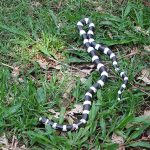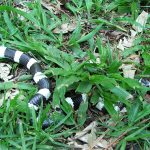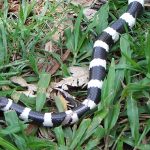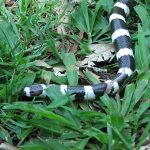BANDY BANDY
The Bandy Bandy
Deep in the sandy soils and grassy woodlands of Australia lurks a truly remarkable serpent—the Bandy Bandy. This strikingly patterned snake is a marvel of the Australian wild, famed for its unique appearance and fascinating behaviours.
Description
The Bandy Bandy is instantly recognisable by its striking black and white banded body. These bold, alternating rings wrap around its slender frame, creating a pattern that stands out both day and night. Adults usually grow to about 50–100 centimetres in length, making them relatively small compared to many other Australian snakes.
- Colouration: Distinct black and white bands encircle the entire body and tail.
- Shape: Slender and cylindrical, perfectly adapted for a burrowing lifestyle.
- Size: Typically 50–100 cm in length.
Habitat and Distribution
The Bandy Bandy is widely distributed across mainland Australia, especially in Queensland, New South Wales, Victoria, and parts of Western Australia and the Northern Territory. It is mainly found in:
- Woodlands
- Open forests
- Grasslands
- Coastal heaths
This snake often prefers loose, sandy soils where it can easily burrow.
Behaviour and Diet
What truly sets the Bandy Bandy apart from other snakes is its defensive behaviour. When threatened, it lifts its body off the ground, creating a series of high, looped curves. This mesmerising display, combined with the snake’s contrasting bands, confuses would-be predators and makes it appear larger and more formidable than it really is.
- Defensive Display: Raises and loops its body when disturbed.
- Nocturnal: Most active at night, rarely seen during the day.
- Diet: Specialises in feeding almost exclusively on blind snakes (Anomalepididae and Typhlopidae).
Venom and Human Interaction
While the Bandy Bandy is a member of the venomous family Elapidae, its venom is not considered dangerous to humans. Bites are extremely rare, as it is a shy and retiring species, preferring flight over fight.
- Venom: Mild, designed to subdue small prey.
- Risk to Humans: Very low; no known fatalities.
Conservation and Importance
The Bandy Bandy is not currently considered threatened and is relatively common within its range. However, habitat destruction and changes in land use can impact local populations. Observing and appreciating creatures like the Bandy Bandy encourages a greater respect and desire to protect Australia’s unique ecosystems.
Sensory Experience
Imagine a night walk in the Australian bush. The cool air carries the scent of eucalypt leaves and damp soil. Suddenly, your torch catches the glint of black and white rings, undulating sinuously across the path. The Bandy Bandy moves with an almost ethereal grace, its loops rising in a silent dance, trying to melt back into the safety of leaf litter and earth.
Conclusion
The Bandy Bandy stands as a wonderful example of Australia’s extraordinary biodiversity. With its striking appearance, gentle nature, and remarkable behaviour, this small snake serves as a reminder of the complex and beautiful web of life that thrives on this continent. By learning more about such fascinating creatures, we take steps towards understanding—and conserving—the extraordinary natural world around us.




